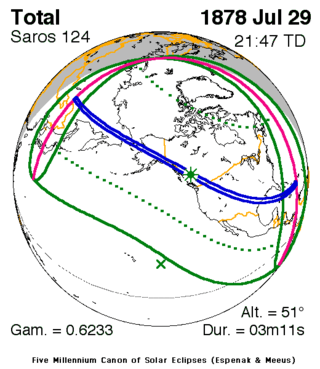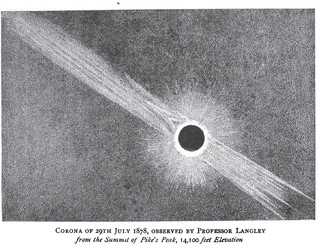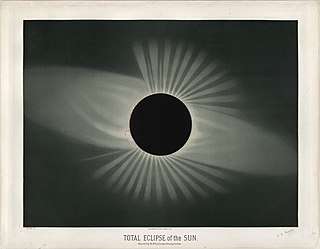Solar eclipse of July 29, 1878
A total solar eclipse occurred on July 29, 1878, over much of North America including the region of the Rocky Mountains. A solar eclipse occurs when the Moon passes between Earth and the Sun, thereby totally or partly obscuring the image of the Sun for a viewer on Earth. A total solar eclipse occurs when the Moon's apparent diameter is larger than the Sun's, blocking all direct sunlight, turning day into darkness. Totality occurs in a narrow path across Earth's surface, with the partial solar eclipse visible over a surrounding region thousands of kilometres wide. This eclipse was visible at sunrise at a path across northeastern Asia and passed across Alaska, western Canada, and the United States from Montana through Texas. It then tracked across most of Cuba and southwestern Hispaniola before ending.
| Solar eclipse of July 29, 1878 | |
|---|---|
 Map | |
| Type of eclipse | |
| Nature | Total |
| Gamma | 0.6232 |
| Magnitude | 1.045 |
| Maximum eclipse | |
| Duration | 191 sec (3 m 11 s) |
| Coordinates | 53.8°N 124°W |
| Max. width of band | 191 km (119 mi) |
| Times (UTC) | |
| Greatest eclipse | 21:47:18 |
| References | |
| Saros | 124 (47 of 73) |
| Catalog # (SE5000) | 9230 |
Newspapers in the United States reported of large migrations from the Midwest towards the path of totality to view the eclipse. Scientists observing from Pikes Peak in Colorado contended with altitude sickness and snowstorms, among other problems.[1][2]
High Altitude Astronomy
The 1878 eclipse was a turning point in modern astronomy, because it was the first time that many of the world's leading astronomers had the opportunity to make their observations from the higher altitudes provided by the Rocky Mountains. After the 1878 eclipse, astronomers began to build observatories at locations well above sea level, including on the sides and summits of mountains, a scientific trend which extended throughout the twentieth century and into the twenty-first.[3]
Eclipse Images
 |
 |
 |
 |
 Étienne Léopold Trouvelot |
References
- Ruskin, Steve (2008). "'Among the Favored Mortals of Earth': The Press, State Pride, and the Great Eclipse of 1878". Colorado Heritage.
- Waxman, Olivia B. (August 18, 2017). "Think This Total Solar Eclipse Is Getting a Lot of Hype? You Should Have Seen 1878". TIME. Retrieved August 22, 2017.
- 1972-, Ruskin, Steven. America's first great eclipse : how scientists, tourists, and the Rocky Mountain eclipse of 1878 changed astronomy forever. [United States]. ISBN 9780999140901. OCLC 992174591.CS1 maint: numeric names: authors list (link)
- NASA graphic
- Sketch of Solar Corona July 29, 1878
- Mabel Loomis Todd (1900). Total Eclipses of the Sun. Little, Brown.
Further reading
- David Baron (2017). American Eclipse: A Nation's Epic Race to Catch the Shadow of the Moon and Win the Glory of the World. Liveright. ISBN 978-1631490163.
- Steve Ruskin (2017). America's First Great Eclipse: How Scientists, Tourists, and the Rocky Mountain Eclipse of 1878 Changed Astronomy Forever. Alpine Alchemy Press. ISBN 978-0999140901.
- Steve Ruskin (2008). "'Among the Favored Mortals of Earth': The Press, State Pride, and the Great Eclipse of 1878." Colorado Heritage 28(3), 22–35.
External links
| Wikimedia Commons has media related to Solar eclipse of 1878 July 29. |
- See You on the Dark Side of the Moon (Notre Dame Magazine)
- The Eclipse That Made America Great (The Atlantic)
.jpg)
